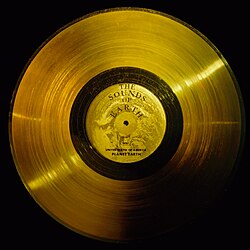Voyager Golden Record
Voyager Golden Records er to fonografiske plader der var fastgjort på de to Voyagerrumsonder, der blev opsendt i 1977.[1] Pladerne indeholder lyde og billeder, der er udvalgt til at vise diversiteten af livet og kultur på Jorden, og de er tilsigtet intelligent udenjordiskesformer, eller fremtidige mennesker, der måtte finde dem. Pladerne bliver betragtet som en slags tidskapsel.
Selvom ingen af Voyager-rumfartøjerne bevæger sig mod nogen særlig stjerne, så vil Voyager 1 passere i en afstand af 1,6 lysår af stjernen Gliese 445, der befinder sig i stjernebilledet Giraffen, om omkring 40.000 år.[2]
Carl Sagan bemærkede at "Rumfartøjet bliver fundet og pladen bliver spillet udelukkende der findes avancerede rumfarende civilisationer i det ydre rum, men opsendelsen af denne "flaske" i det kosmiske "hav" fortæller noget meget håbefuldt om denne planet." [3]
Se også
Referencer
- ^ Lafrance, Adrienne (30. juni 2017). "Solving the Mystery of Whose Laughter Is On the Golden Record". The Atlantic. Hentet 1. juli 2017.
- ^ "Voyager – Interstellar Mission". Jet Propulsion Laboratory. NASA. 25. januar 2010.
- ^ "Voyager – Golden Record". Jet Propulsion Laboratory. NASA. Hentet 23. september 2010.
| Spire Denne artikel om rumfart er en spire som bør udbygges. Du er velkommen til at hjælpe Wikipedia ved at udvide den. |
Medier brugt på denne side
Voyager Golden Record
This gold aluminium cover was designed to protect the Voyager 1 and 2 "Sounds of Earth" gold-plated records from micrometeorite bombardment, but also serves a double purpose in providing the finder a key to playing the record.
The explanatory diagram appears on both the inner and outer surfaces of the cover, as the outer diagram will be eroded in time. Flying aboard Voyagers 1 and 2 are identical "golden" records, carrying the story of Earth far into deep space. The 12 inch gold-plated copper discs contain greetings in 60 languages, samples of music from different cultures and eras, and natural and man-made sounds from Earth. They also contain electronic information that an advanced technological civilization could convert into diagrams and photographs. Currently, both Voyager probes are sailing adrift in the black sea of interplanetary space, flying towards the outmost border of our solar system.A drawing of NASA's Space Shuttle Challenger. Image provided by Dryden Flight Research Center at Edwards Air Force Base, California. See [1], specifically EG-0076-04.eps.
Flying aboard Voyagers 1 and 2 are identical "golden" records, carrying the story of Earth far into deep space. The 12 inch gold-plated copper discs contain greetings in 60 languages, samples of music from different cultures and eras, and natural and man-made sounds from Earth. They also contain electronic information that an advanced technological civilization could convert into diagrams and photographs.
The cover of each gold plated aluminum jacket, designed to protect the record from micrometeorite bombardment, also serves a double purpose in providing the finder a key to playing the record. The explanatory diagram appears on both the inner and outer surfaces of the cover, as the outer diagram will be eroded in time.
Currently, both Voyager probes are sailing adrift in the black sea of interstellar space, having left our solar system years ago.



